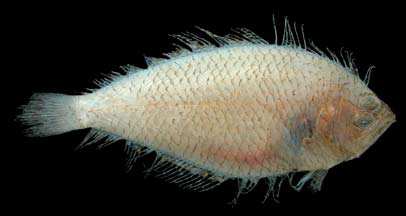CITHARIDAE
Largescale Flounders
By Seishi Kimura
 Brachypleura novaezeelandiae |
|
Small sized marine flatfishes; maximum size less than 40 cm. Body somewhat elongated, elliptical, strongly compressed. Both eyes on left side of head. Mouth moderate or somewhat large, superior, reaching to or beyond center of lower eye. Jaw teeth small, slender. Preopercular margin visible, not covered with skin. Gill rakers slender with small spines. Dorsal-fin origin anterior to posterior margin of upper eye; anterior rays of dorsal and anal fins not spinous; caudal fin apart from dorsal and anal fins, with 13-15 branched fin rays; pectoral fins present on both sides of body, with 9-13 soft rays; pelvic fins short based, with I spine and 5 soft rays. Body covered with large ctenoid scales on eyed side, cycloid or weakly ctenoid scales on eyeless side; lateral lines usually developed on both sides of body, with high arch over pectoral fin. Color: body on eyed side brownish; eyeless side of body whitish. Similar families occurring in the area. Citharidae is distinguished from other Indo-Pacific flatfish families in having a pelvic-fin spine but no dorsal- and anal-fin spines. Psettodidae: dorsal-fin origin posterior to posterior margin of upper eye; anterior rays of dorsal and anal fins spinous; lateral line without high arch over pectoral fin. Paralichthyidae and Bothidae: no pelvic-fin spine. Samaridae and Pleuronectidae: no pelvic-fin spines; eyes in most species on right side of body. Remarks. Usually found on sandy or muddy-sandy bottoms, caught by trawls. Feeds on benthic animals. Five genera, Brachypleura, Citharoides, Citharus, Lepidoblepharon, and Paracitharus. Food fish. |

|
|